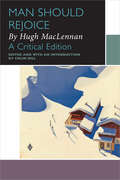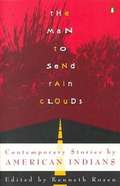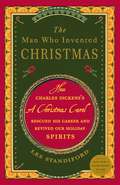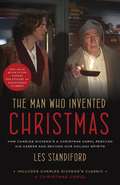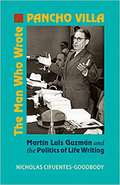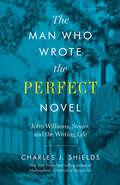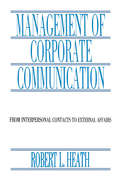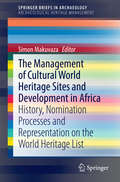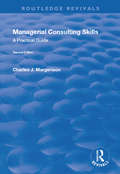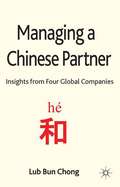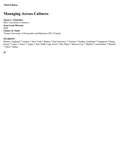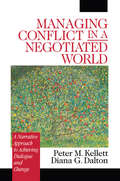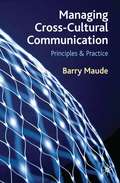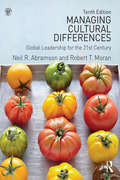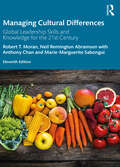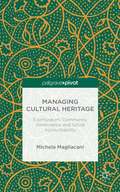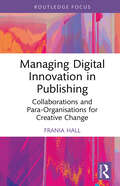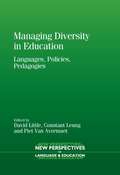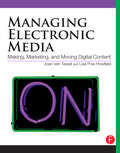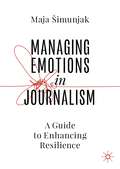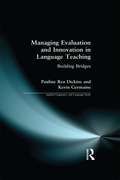- Table View
- List View
Man Should Rejoice, by Hugh MacLennan: A Critical Edition (Canadian Literature Collection)
by Hugh MacLennanMan Should Rejoice is one of two hitherto unpublished novels by acclaimed novelist Hugh MacLennan. Completed in 1937 and left unpublished due to economic conditions during the Great Depression, it lay in the McGill archives until now. This critical edition of Man Should Rejoice , which is also the first-ever publication of the work, is comprised of a critical introduction, a bibliography of published and unpublished sources, a fully-edited text based on a typescript of the novel, a list of textual emendations, and explanatory notes. The introduction draws upon extensive research undertaken in three Canadian archival collections located in Montreal and Calgary. It provides relevant historical, cultural, and biographical context for the novel. From hundreds of archival documents, Colin Hill reconstructs a textual history of the novel’s production that acknowledges the crucial contribution of Dorothy Duncan, who heavily revised the text and assisted MacLennan behind the scenes. Hill also explores the critical reception of MacLennan’s fiction from the 1930s to the present. This book is published in English. - Man Should Rejoice est un des deux romans inédits du grand romancier Hugh MacLennan. Terminé en 1937, il fut victime de la Grande Crise et fut conservé dans les archives de McGill jusqu’à maintenant. Cette édition critique de Man Should Rejoice comprend une introduction critique, une bibliographie des sources publiées et non publiées, le texte révisé tiré d’un tapuscrit du roman, une liste des emendations textuelles, et des notes explicatives. L’introduction, qui repose sur des recherches archivistiques poussées de trois collections canadiennes situées à Montréal et à Calgary, fournit le contexte historique, culturel et biographique du roman. Colin Hill érige l’histoire textuelle de l’écriture de ce roman à partir de centaines de documents d’archives qui jettent la lumière sur la contribution clé de Dorothy Duncan, qui a révisé en profondeur le texte et a aidé MacLennan en coulisses. Il explore par ailleurs la réception critique de la fiction de MacLennan, des années 1930 jusqu’à aujourd’hui. Ce livre est publié en anglais.
The Man to Send Rain Clouds: Contemporary Stories by American Indians
by Kenneth RosenThe stories in this collection--now updated with a new introduction--reflect the modern experience of white-educated Indians, bitterly aware that their culture is threatened with destruction, trying to bear witness through a non-Indian genre: the short story.
The Man Who Invented Christmas: How Charles Dickens's A Christmas Carol Rescued His Career and Revived Our Holiday Spirits
by Les StandifordAs uplifting as the tale of Scrooge itself, this is the story of how one writer and one book revived the signal holiday of the Western world.Just before Christmas in 1843, a debt-ridden and dispirited Charles Dickens wrote a small book he hoped would keep his creditors at bay. His publisher turned it down, so Dickens used what little money he had to put out A Christmas Carol himself. He worried it might be the end of his career as a novelist.The book immediately caused a sensation. And it breathed new life into a holiday that had fallen into disfavor, undermined by lingering Puritanism and the cold modernity of the Industrial Revolution. It was a harsh and dreary age, in desperate need of spiritual renewal, ready to embrace a book that ended with blessings for one and all.With warmth, wit, and an infusion of Christmas cheer, Les Standiford whisks us back to Victorian England, its most beloved storyteller, and the birth of the Christmas we know best. The Man Who Invented Christmas is a rich and satisfying read for Scrooges and sentimentalists alike.From the Hardcover edition.
The Man Who Invented Christmas (Movie Tie-In): How Charles Dickens's A Christmas Carol Rescued His Career and Revived Our Holiday Spirits
by Les StandifordAs uplifting as the tale of Scrooge itself, this is the story of how Charles Dickens revived the signal holiday of the Western world. Soon to be a major motion picture. Just before Christmas in 1843, a debt-ridden and dispirited Charles Dickens wrote a small book he hoped would keep his creditors at bay. His publisher turned it down, so Dickens used what little money he had to put out A Christmas Carol himself. He worried it might be the end of his career as a novelist. The book immediately caused a sensation. And it breathed new life into a holiday that had fallen into disfavor, undermined by lingering Puritanism and the cold modernity of the Industrial Revolution. It was a harsh and dreary age, in desperate need of spiritual renewal, ready to embrace a book that ended with blessings for one and all. With warmth, wit, and an infusion of Christmas cheer, Les Standiford whisks us back to Victorian England, its most beloved storyteller, and the birth of the Christmas we know best. The Man Who Invented Christmas is a rich and satisfying read for Scrooges and sentimentalists alike.
The Man Who Loved Books Too Much: The True Story of a Thief, a Detective, and a World of Literary Obsession
by Allison Hoover BartlettThis is the story of John Gilkey, a man who repeatedly stole rare books, and the journalist who tells of, and gets caught up in, his exploits.
The Man Who Wrote Pancho Villa: Martin Luis Guzman and the Politics of Life Writing
by Nicholas Cifuentes-GoodbodyMartin Luis Guzman was many things throughout his career in twentieth-century Mexico: a soldier in Pancho Villa's revolutionary army, a journalist-in-exile, one of the most esteemed novelists and scholars of the revolutionary era, and an elder statesman and politician. In The Man Who Wrote Pancho Villa, we see the famous author as he really was: a careful craftsman of his own image and legacy. His five-volume biography of Villa propelled him to the heights of Mexican cultural life, and thus began his true life's work. Nicholas Cifuentes-Goodbody shapes this study of Guzman through the lens of "life writing" and uncovers a tireless effort by Guzman to shape his public image.The Man Who Wrote Pancho Villa places Guzman's work in a biographical context, shedding light on the immediate motivations behind his writing in a given moment and the subsequent ways in which he rewrote or repackaged the material. Despite his efforts to establish a definitive reading of his life and literature, Guzman was unable to control that interpretation as audiences became less tolerant of the glaring omissions in his self-portrait.
The Man Who Wrote Pancho Villa: Martin Luis Guzman and the Politics of Life Writing
by Nicholas Cifuentes-GoodbodyMartin Luis Guzman was many things throughout his career in twentieth-century Mexico: a soldier in Pancho Villa's revolutionary army, a journalist-in-exile, one of the most esteemed novelists and scholars of the revolutionary era, and an elder statesman and politician. In The Man Who Wrote Pancho Villa, we see the famous author as he really was: a careful craftsman of his own image and legacy. His five-volume biography of Villa propelled him to the heights of Mexican cultural life, and thus began his true life's work. Nicholas Cifuentes-Goodbody shapes this study of Guzman through the lens of "life writing" and uncovers a tireless effort by Guzman to shape his public image.The Man Who Wrote Pancho Villa places Guzman's work in a biographical context, shedding light on the immediate motivations behind his writing in a given moment and the subsequent ways in which he rewrote or repackaged the material. Despite his efforts to establish a definitive reading of his life and literature, Guzman was unable to control that interpretation as audiences became less tolerant of the glaring omissions in his self-portrait.
The Man Who Wrote the Perfect Novel: John Williams, Stoner, and the Writing Life
by Charles J. ShieldsAn &“engrossing&” biography of a brilliant novelist underappreciated in his own time who became a twenty-first-century bestseller, from the New York Times–bestselling author (The New Yorker). When Stoner was published in 1965, the novel sold only a couple of thousand copies before disappearing with hardly a trace. Yet the quietly powerful tale of Midwestern college professor William Stoner, whose life becomes a parable of solitude and anguish, eventually found an admiring audience in America and especially in Europe. The New York Times called Stoner &“a perfect novel,&” and a host of writers and critics, including Colum McCann, Julian Barnes, Bret Easton Ellis, Ian McEwan, Emma Straub, Ruth Rendell, C.P. Snow, and Irving Howe, praised its artistry. The New Yorker deemed it &“a masterly portrait of a truly virtuous and dedicated man.&” This biography traces the life of Stoner&’s author, John Williams. Charles J. Shields follows the whole arc of Williams&’s life, which in many ways paralleled that of his titular character, from their shared working-class backgrounds to their undistinguished careers in academia. Shields vividly recounts Williams&’s development as an author, whose other works include the novels Butcher&’s Crossing and Augustus (for the latter, Williams shared the 1972 National Book Award). Shields also reveals the astonishing afterlife of Stoner, which garnered new fans with each American reissue, and then became a bestseller all over Europe after a Dutch publisher brought out a translation in 2013. Since then, Stoner has been published in twenty-one countries and sold over a million copies. &“Like Williams, Shields know how to tell a good story, one that will appeal especially to those interested in the ins and outs of the publishing industry and the ups and downs of a writer&’s life.&” —Los Angeles Review of Books
The Man Who Wrote the Perfect Novel: John Williams, Stoner, and the Writing Life
by Charles J. ShieldsAn &“engrossing&” biography of a brilliant novelist underappreciated in his own time who became a twenty-first-century bestseller, from the New York Times–bestselling author (The New Yorker). When Stoner was published in 1965, the novel sold only a couple of thousand copies before disappearing with hardly a trace. Yet the quietly powerful tale of Midwestern college professor William Stoner, whose life becomes a parable of solitude and anguish, eventually found an admiring audience in America and especially in Europe. The New York Times called Stoner &“a perfect novel,&” and a host of writers and critics, including Colum McCann, Julian Barnes, Bret Easton Ellis, Ian McEwan, Emma Straub, Ruth Rendell, C.P. Snow, and Irving Howe, praised its artistry. The New Yorker deemed it &“a masterly portrait of a truly virtuous and dedicated man.&” This biography traces the life of Stoner&’s author, John Williams. Charles J. Shields follows the whole arc of Williams&’s life, which in many ways paralleled that of his titular character, from their shared working-class backgrounds to their undistinguished careers in academia. Shields vividly recounts Williams&’s development as an author, whose other works include the novels Butcher&’s Crossing and Augustus (for the latter, Williams shared the 1972 National Book Award). Shields also reveals the astonishing afterlife of Stoner, which garnered new fans with each American reissue, and then became a bestseller all over Europe after a Dutch publisher brought out a translation in 2013. Since then, Stoner has been published in twenty-one countries and sold over a million copies. &“Like Williams, Shields know how to tell a good story, one that will appeal especially to those interested in the ins and outs of the publishing industry and the ups and downs of a writer&’s life.&” —Los Angeles Review of Books
Management of Corporate Communication: From Interpersonal Contacts To External Affairs (Routledge Communication Ser.)
by Robert L. HeathWhereas many organizational communication texts address internal communication processes, few consider the efforts that companies expend to communicate with external stakeholders. Likewise, many texts that concentrate on public relations or advertising consider external communication, but fail to give attention to internal communication. Combining both points of view, this text explains how an entire organization operates through enactments of personnel and external stakeholders. Central to this book is a concern for meaning and its influence on the performance of jobs in response to expectations of co-workers and external publics. The concept of narrative is used to explain how individual and organization performance is the expression of personae that are best when enacted jointly -- in varying degrees of coordination -- to satisfy mutual performance expectations. Narrative explains the power of organizational meaning, interpersonal contacts, group performance, stakeholder negotiation, and internal and external organizational zones of meaning -- assumptions that are shared by people who enact an organization through coordinated efforts.
The Management Of Cultural World Heritage Sites and Development In Africa
by Simon MakuvazaEver since the signing of the World Heritage Convention 40 years ago and ratified by 33 African countries, to date, only 43 cultural heritage sites have been successfully proclaimed as World Heritage Sites in Africa. These include archaeological and historical sites, religious monuments and cultural landscapes This book is a re-evaluation of the nomination and management of cultural World Heritage sites in Africa from the late 1970s when the Island of Gorée of Senegal and the Rock-Hewn Churches of Ethiopia were first inscribed on the WHL until today It considers whether a credible and well balanced WHL has been attained, especially in regards to the nomination of more sites in Africa. The book also examines the roles and contribution of various heritage organizations and African governments to the nomination and management of cultural World Heritage sites in Africa. Lastly, the volume also scrutinizes economic development, which may result from the nomination and successful management of cultural World Heritage sites in Africa.
Managerial Consulting Skills: A Practical Guide (Routledge Revivals)
by Charles J. MargerisonThis title was first published in 2001. The advisory role in organizations is more important today than it has ever been. To perform effectively, managers and professionals need the skills of the consultant. This manual is designed to provide practical help for all advisers, whether working within or outside the organization. It covers every aspect of the process, from interpersonal skills to organizational context, from planning to follow-up. This second edition reflects developments which have taken place since the publication of the first edition and now includes ten chapters on the impact that action learning has on change processes and the way that the Web is likely to influence consulting. Each chapter concludes with guidelines summarizing the content, and questions designed to help the reader to apply the material to his or her own activities. Real-life cases from Dr Margerison's own experience are included, as well as examples drawn from the work of many well-known consultants.
Managing a Chinese Partner
by Lub Bun ChongFrom 2007 to 2009, French food and beverage giant Danone and Chinese entrepreneur Zong Qinghou who is ranked number one on Forbes' China Rich List 2012 were embroiled in a highly rancorous dispute over their joint venture, Hangzhou Wahaha. It transpired that even French President Sarkozy reportedly found time in his 2007 three-day state visit to China to discuss the 'Wahaha' dispute with his Chinese counterpart, President Hu. Behind the melodrama of the 'Wahaha' dispute lies an important lesson for foreign companies in China. As a result of the global shift in power, the imperative for a foreign company to manage its Chinese Partner has never been stronger since China re-opened its doors for business in 1978. By drawing on the experiences of Danone, Nestle, Coca-Cola and SABMiller, this book provides an insight into why, as well as, how the managing of a Chinese Partner can deliver sustainable value for a joint venture in China. "
Managing Across Cultures
by Susan Schneider Jean-Louis Barsoux Günter StahlThis is a book about managing across cultures: the threats and opportunities, the problems and possibilities. Rather than experiencing cultural differences as threats to be overcome or as unfortunate remnants of history to be endured, we challenge the reader to experience and enjoy the richness of cultural differences. Rather than creating a cultural melting pot, we need to design organisations as cultural mosaics in which each element preserves its unique value.
Managing Conflict in a Negotiated World: A Narrative Approach to Achieving Productive Dialogue and Change
by Diana G. Dalton Dr Peter M. KellettKellett and Dalton present a core text in Conflict Management derived from extensive class testing of their material. Their book helps readers understand the elements of conflict and act on that understanding by managing conflict better in each area of their lives - work, family, and community.
Managing Conflict in a Negotiated World: A Narrative Approach to Achieving Productive Dialogue and Change
by Dr. Peter M. Kellett Diana G. DaltonKellett and Dalton present a core text in Conflict Management derived from extensive class testing of their material. Their book helps readers understand the elements of conflict and act on that understanding by managing conflict better in each area of their lives - work, family, and community.
Managing Cross-cultural Communication: Principles And Practice
by Barry MaudeAn accessible and lively introduction to the management of cross-cultural communication for undergraduate and graduate business students. Drawing on the latest research and incorporating the author's own extensive experience of working in different cultural settings, it addresses the core theory and practice. An essential course companion.
Managing Cultural Differences: Global Leadership for the 21st Century (Managing Cultural Differences Ser.)
by Robert T. Moran Neil Remington AbramsonIn today’s global business environment, it is vital that individuals and organizations have sophisticated global leadership skills. Communication and understanding of different cultures is paramount to business success. This new edition of the bestselling textbook, Managing Cultural Differences, guides students and practitioners to an understanding of how to do business internationally, providing practical advice on how competitive advantage can be gained through effective cross-cultural management. Crises in the Middle East, the weakening of some emerging markets, and the value of diversity and inclusion are just a few examples of contemporary issues discussed in this text, which also introduces a completely new chapter on global business ethics. With a wealth of new examples, case studies, and online materials, this textbook is required course reading for undergraduates, postgraduates, and MBA students alike, as well as being a vital tool for anybody selling, purchasing, traveling, or working internationally.
Managing Cultural Differences: Global Leadership Skills and Knowledge for the 21st Century
by Robert Moran Neil Abramson Anthony Chan Sabongui Marie-MargueriteIn today’s global business environment, it is vital that individuals and organizations have sophisticated global leadership skills. Communication and understanding of different cultures are paramount to business success. This new edition of the bestselling textbook Managing Cultural Differences guides students and practitioners to an understanding of how to do business internationally, providing practical advice on how competitive advantage can be gained through effective cross-cultural management. The digitization of the workplace, the integration of artificial intelligence into workplace cultures, cultural responses to crisis, and the value of diversity and inclusion are just a few examples of contemporary issues discussed in this text. This latest edition also begins with a completely new introductory chapter, which provides an overview and connects the themes between chapters for an integrated understanding of the topic. With a wealth of new examples, case studies, and online materials, this textbook is required course reading for undergraduates, postgraduates, and MBA students alike, as well as being a vital tool for anybody selling, purchasing, traveling, or working internationally.
Managing Cultural Heritage: Ecomuseum, Community Governance and Social Accountability
by Michela MagliacaniManaging Cultural Heritage explores managerial and governance issues within the cultural heritage sector, with particular regard to the ecomuseum. Moreover, a social accountability model is supplied to ecomuseums in order to be accountable towards its shareholder, the local community.
Managing Digital Innovation in Publishing: Collaborations and Para-Organisations for Creative Change
by Frania HallReflecting proactively on a growing industry 'dilemma', this book explores how publishing businesses can and do successfully experiment and innovate in digital publishing through collaboration.Many sectors of publishing are still structured around print production, with digital innovation in the consumer arena generally focused on different book formats, such e-books and audiobooks, rather than on brand-new types of products. Publishers need to innovate around different sorts of content and digital formats as consumers change their media habits. However, their pricing, business and risk models, and workflows are reflective of a legacy of print publishing; and as print commands so much revenue, publishers do not want to derail their main business as they experiment. Drawing on an analysis of collaboration and network theory and four in-depth qualitative case studies in different sectors, this research suggests that collaboration, particularly engaging with the wider creative sector, is key to the sustainable development of new types of products. It points to the characteristics of a successful digital collaboration and explains how to manage publishing innovation alongside the existing business, through para-organisations. Considering novel approaches to innovation, such as iterative software-style approaches and agile project management, as well as new business models, such as those employed in games development, the author shows how introducing new people – from software developers to competitors – can help instill a collaborative mindset within the organisation and facilitate constructive experimentation.Managing Digital Innovation in Publishing will be of interest to upper-level students and researchers of (digital) publishing and related creative industries.
Managing Diversity in Education
by Constant Leung David LittleDiversity - social, cultural, linguistic and ethnic - poses a challenge to all educational systems. Some authorities, schools and teachers look upon it as a problem, an obstacle to the achievement of national educational goals, while for others it offers new opportunities. Successive PISA reports have laid bare the relative lack of success in addressing the needs of diverse school populations and helping children develop the competences they need to succeed in society. The book is divided into three parts that deal in turn with policy and its implications, pedagogical practice, and responses to the challenge of diversity that go beyond the language of schooling. This volume features the latest research from eight different countries, and will appeal to anyone involved in the educational integration of immigrant children and adolescents.
Managing Electronic Media: Making, Moving and Marketing Digital Content
by Joan Van TasselThis college-level media management textbook reflects the changes in the media industries that have occurred in the past decade. Today's managers must address new issues that their predecessors never faced, from the threats of professional piracy and casual copying of digital media products, to global networks, on-demand consumption, and changing business models. The book explains the new new vocabulary of media moguls, such as bandwidth, digital rights management, customer relations management, distributed work groups, centralized broadcast operations, automated playlists, server-based playout, repurposing, mobisodes, TV-to-DVD, and content management. The chapters logically unfold the ways that managers are evolving their practices to make content, market it, and deliver it to consumers in a competitive, global digital marketplace. In addition to media companies, this book covers management processes that extend to all content-producing organizations, because today's students are as likely to produce high-quality video and Web video for ABC Computer Sales as they are for the ABC Entertainment Television Network.
Managing Emotions in Journalism: A Guide to Enhancing Resilience
by Maja ŠimunjakThis textbook offers the first practical guide to managing emotions in everyday journalism work based on interviews with more than 30 British journalists. It raises awareness of emotional situations and stressors journalists may face, so practitioners are better able to recognise these and prepare for them, and outlines practical emotion management strategies which they can apply to enhance their emotional intelligence and resilience and consequently, feel and perform better in the workplace. It includes vignettes written by journalists from the United Kingdom, United States, Australia and Croatia, as well as practical scenario exercises that prompt readers to reflect on how they would feel and react in specific situations based on journalists’ everyday work.
Managing Evaluation and Innovation in Language Teaching: Building Bridges (Applied Linguistics and Language Study)
by Pauline Rea Dickins Kevin GermaineManaging Evaluation and Innovation in Language Teaching focuses on the connections to be made between evaluation and change in language education with a specific focus on English Language Teaching. The book demonstrates the central importance of evaluation in relation to language projects and programmes, the management of change and innovation, and in improving language teacher development. The introductory chapter provides an overview of the present trends in evaluation as well as offering examples of recent evaluation projects. Subsequent chapters identify contemporary issues in evaluation and their relevance to language teaching, covering a number of cultural and ethnographic studies in evaluation management in different world-wide contexts, as well as drawing insights from other related disciplines. The editors seek to draw attention to the possibilities of inter-disciplinary exchange to inform the reader of current practice, and highlight emerging issues in the expanding field of evaluation in language teaching, especially in ELT. The contemporary nature of the studies presented here will be relevant to both post graduate students following language education programmes as well as to professionals involved in language teaching. It will be of particular interest to those involved in the management of innovation and the evaluation of projects and programmes, such as curriculum developers, Director of Studies, and professionals with a special responsibility for bringing about change in language teaching contexts.
